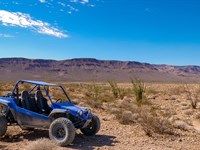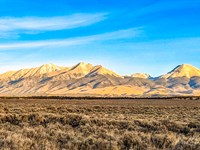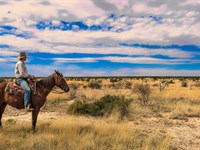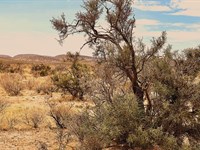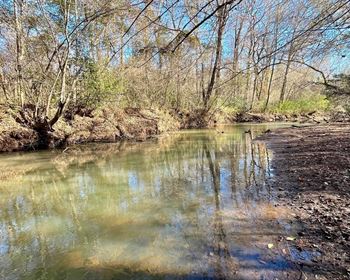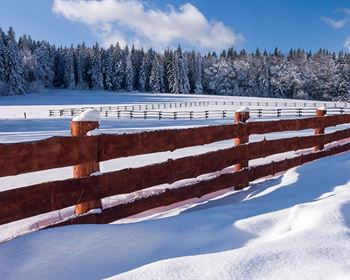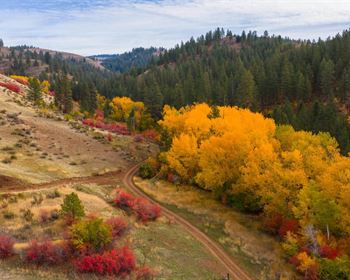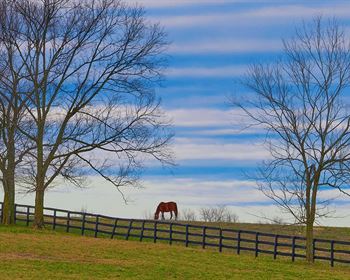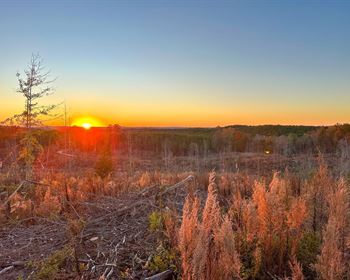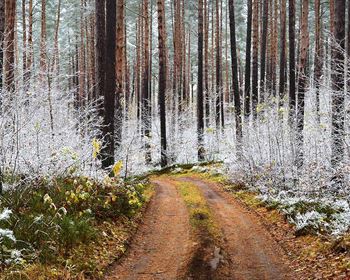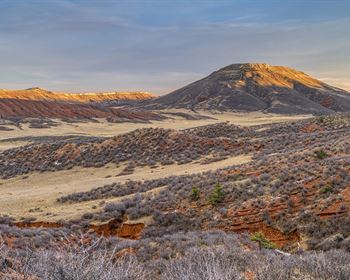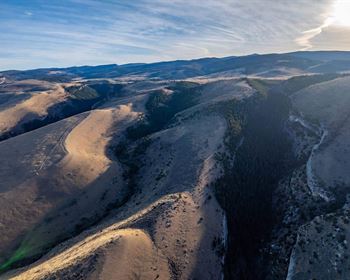Huge Lot with Views & Trees
Fort Garland, CO 81133
Costilla County, Colorado
Farm Description
Welcome to 18.07 acres of prime land in the beautiful Sangre de Cristo Ranches in Colorado. This vast property is perfect for recreational camping or building your dream home. With tree coverage and varied terrain, you'll have plenty of opportunities to explore and enjoy the great outdoors.
Located just 10 miles from the charming town of Fort Garland, you'll have easy access to all the amenities you need. And with Mountain Home Reservoir just a short drive away, you'll have plenty of opportunities for fishing and boating.
But the real selling point of this property is the stunning views. The land is situated in a prime location, giving you breathtaking panoramic views of the surrounding landscape.
As a bonus, the property also includes a dirt driveway for easy access. Also of note: there are two older camping trailers in unknown condition on the property - these would be included with the purchase of the land, and could be removed by the buyer.
Don't miss out on the opportunity to own this incredible 18.07 acre property in the beautiful Sangre de Cristo Ranches. Contact us today to learn more.
We are open to owner financing as well - here is what that would look like:
- Total Money Down: $1750 ($1500 downpayment + $250 closing cost)
- Monthly: $599/Month for 96 months
See Info below.
- Subdivision: Sangre de Cristo Ranches
- State: Colorado
- County: Costilla
- Zip: 81133
- Size: 18.07 acres
- Parcel: 70244920 and 70244930
- Legal Description: S.D.C.R. Unit K-3 BLK 344 Lot 7591 and S.D.C.R. Unit K-3 BLK 344 Lot 7590
- Approximate Lat/Long Coordinates:
37.4719, -105.2873
37.4702, -105.2832
37.4688, -105.2843
37.4705, -105.2883
- Annual Taxes: Approximately $789/Year
- Zoning: Estate Residential (Er)
--- For a site built home, you need a 600 sqft minimum footprint.
--- Mobile homes are Allowed.
--- You can camp for 14 days (every 3 months)
--- Temporary RV Occupancy permit available for up to 180 days if a well has been permitted or cistern installed and a septic or onsite waste management system has been installed ($250 fee - good for 60 days at a time while building, renewable).
--- Zoning office is open Monday through Thursday and can be contacted at to answer any questions.
- Hoa/Poa: No. Minor restrictions, but no HOA to enforce them
- Improvements: Dirt Driveway
- Access: Dirt Road (Mallot)
- Water: Would be by well or holding tank
- Sewer: Would be by septic or alternative
- Utilities: Alternative Energy (Solar, wind, or generator), Phone would be cellular or Satellite. Tv/Internet would be Satellite
Information presented in this listing is deemed accurate but is not guaranteed. Buyers are advised to conduct their own due diligence and verify all details independently.
---
Location And Setting Overview
- Your Mountain Sanctuary in Colorado's Most Historic Ranch Community: This remarkable 18.07-Acre property sits in the heart of Sangre de Cristo Ranches, positioned perfectly on the eastern edge of the legendary San Luis Valley where the valley floor meets the dramatic Sangre de Cristo Mountain Range. At 7,900 feet elevation, your land occupies one of Colorado's most spectacular settings - where the high desert grasslands transition into the foothills of some of the state's most impressive peaks.
- Geographic Position and Mountain Access: Your property coordinates place you approximately 10 miles south of Fort Garland along the eastern valley corridor, with direct views toward the towering Sangre de Cristo Range that rises over 6,000 feet above the valley floor. This positioning gives you the best of both worlds - the open vistas and sunshine of the San Luis Valley combined with immediate proximity to mountain wilderness. The Sangre de Cristo Mountains, whose Spanish name means "Blood of Christ" for their crimson alpenglow at sunrise and sunset, form your eastern horizon with peaks like Mount Blanca at 14,345 feet, Culebra Peak at 14,047 feet, and the Trinchera massif creating an ever-changing backdrop of shadows, light, and seasonal snow.
- The Sangre de Cristo Ranches Legacy: You're not just buying land - you're becoming part of a storied Colorado community. Sangre de Cristo Ranches was originally part of the historic Forbes Trinchera Ranch, one of Colorado's legendary working ranches that operated for over a century. The subdivision was carefully planned to preserve the ranching character while providing families with individual homesites in this spectacular mountain setting. Unlike many subdivisions, the original developers set aside over 5,000 acres of common greenbelt land for recreational use by property owners, continuing the communal land-use traditions that date back to the area's Spanish land grant origins. This shared recreation area provides you with access to vastly more territory than just your private 18 acres.
- Fort Garland and Regional Services: Just 10 miles north lies the historic community of Fort Garland, your closest hub for essential services and fascinating frontier history. Fort Garland was established in 1858 as a U.S. Army outpost to protect settlers and maintain peace with the Ute Indians. The fort's most famous commander was legendary frontiersman Kit Carson, who served here from 1866 to 1867. Today, the beautifully preserved fort operates as a museum where you can walk through original adobe barracks, officers' quarters, and exhibits featuring the Buffalo Soldiers who served here. Beyond history, Fort Garland provides practical amenities including a grocery store and general supply shop, gas station, several restaurants serving hearty breakfasts and classic southwestern cuisine, and basic services. Highway 160 passes through Fort Garland, making it your gateway to larger towns and mountain recreation.
- Mountain Home Reservoir Recreation: One of your property's greatest advantages is proximity to Mountain Home Reservoir, approximately 20 miles northeast in the Sangre de Cristo foothills. This spectacular mountain reservoir holds 19,500 acre-feet of crystal-clear water at over 9,000 feet elevation and ranks as one of southern Colorado's premier fishing destinations. The reservoir is regularly stocked with rainbow trout and brown trout, with many anglers consistently catching fish in the 14 to 20-inch range. Trophy trout over 24 inches are landed here every season by skilled fishermen who know the waters. The reservoir features boat launches allowing you to explore the entire shoreline, and primitive camping sites let you spend weekends fishing from dawn to dusk. Whether you prefer trolling from a boat, casting from shore, or fly fishing the inlet streams, Mountain Home Reservoir delivers world-class mountain angling just minutes from your property.
- San Luis - Colorado's Oldest Town: Thirty-five miles south lies San Luis, the oldest continuously occupied town in Colorado, founded in 1851 by Hispanic settlers from Taos, New Mexico. San Luis retains its authentic Spanish Colonial character with original plaza layout, historic adobe architecture, and strong cultural traditions. The town is home to the famous Stations of the Cross shrine on Mesa de los Santos, where life-size bronze sculptures by local artist Huberto Maestas depict Christ's final journey. Thousands of pilgrims walk this devotional trail annually, especially during Holy Week. San Luis also features the R&R Market, Colorado's oldest continuously operating business since 1857, where locals still gather for groceries and conversation. The town provides basic services including a health clinic, post office, gas station, and several restaurants serving authentic Northern New Mexican cuisine with red and green chile. The community celebrates its heritage through traditional festivals and maintains centuries-old acequia irrigation systems still in use today.
- Alamosa - Your Regional Shopping Hub: For major shopping and services, Alamosa sits approximately 35 miles northwest and serves as the San Luis Valley's commercial center with a population around 9,000. Alamosa offers everything you need for modern living while maintaining small-town friendliness. The city features major retailers including Walmart Supercenter, Home Depot, Safeway, and City Market for comprehensive shopping. San Luis Valley Regional Medical Center provides full hospital services with emergency room, surgical facilities, and specialty clinics. Adams State University brings cultural offerings including concerts, theater performances, and sporting events. Downtown Alamosa's historic Main Street district offers diverse restaurants, breweries, coffee shops, and boutique stores. When you need building supplies for your property, automotive services, banking, or specialized medical care, Alamosa delivers without the crowds and expense of larger cities.
- Strategic Mountain Position Between Two States: Your property occupies a unique position near the Colorado-New Mexico border, giving you access to attractions and services in both states. The legendary art town of Taos, New Mexico, sits approximately 50 miles south, offering world-class galleries, restaurants, skiing at Taos Ski Valley, and the Unesco World Heritage Site of Taos Pueblo. This proximity means you can enjoy New Mexico's distinctive culture and cuisine on day trips while benefiting from Colorado's superior property taxes and development freedoms. The nearby border crossing at Costilla also provides a scenic route into northern New Mexico's high country.
- Climate Perfection at 7,900 Feet: Your elevation delivers ideal mountain climate without the extremes of higher altitudes. At 7,900 feet, you experience four distinct seasons with approximately 300 days of sunshine annually - more sunny days than San Diego, California. Summer days typically reach comfortable mid-70s to low 80s with cool evenings dropping into the 40s, perfect for sleeping without air conditioning. Winter brings manageable snowfall and daytime highs often in the 30s with brilliant sunshine that quickly melts snow from south-facing slopes. The high desert climate means low humidity year-round, making hot days comfortable and cold days more tolerable than humid climates. This elevation is high enough to escape valley inversions and pollution while remaining low enough for year-round access and comfortable living.
Recreational Opportunities
- Your Gateway to Wilderness Adventure: Owning property in Sangre de Cristo Ranches means living at the doorstep of some of Colorado's most spectacular and least-crowded recreational opportunities. While Front Range residents fight traffic and crowds to reach the mountains, you wake up surrounded by them. Your property provides immediate access to millions of acres of public lands, world-class fishing, trophy hunting, challenging fourteener climbs, and winter sports that rival anywhere in the Rocky Mountains.
- Fourteen-Thousand-Foot Peak Access: The Sangre de Cristo Range rising directly east of your property contains some of Colorado's most impressive fourteeners, and your location provides excellent access to these alpine giants. Mount Blanca at 14,345 feet stands as Colorado's fourth-highest peak and dominates your northeastern horizon. The standard route up Blanca starts from Como Lake trailhead, approximately 45 minutes from your property, and follows a challenging but non-technical path through pristine wilderness to the spectacular summit with views spanning three states. Experienced climbers can also tackle neighboring Ellingwood Point and Little Bear Peak from the same drainage. Culebra Peak at 14,047 feet represents Colorado's southernmost fourteener and offers a more exclusive climbing experience on private land requiring advance permission. The peak's remote location and limited access mean you'll share the summit with far fewer people than popular Front Range fourteeners.
- Sangre de Cristo Wilderness Exploration: The Sangre de Cristo Wilderness encompasses 220,000 acres of designated wilderness where motorized vehicles are prohibited and nature reigns supreme. Your property sits within 20 minutes of multiple wilderness access points where maintained trails lead into pristine backcountry. The wilderness contains over 50 alpine lakes nestled in glacial cirques, perfect for backcountry fishing and photography. Miles of maintained trails accommodate all skill levels from gentle valley hikes to challenging scrambles above treeline. The wilderness's position on the valley's eastern edge means you can hike from desert grasslands through pinyon-juniper woodlands, into aspen groves and spruce-fir forests, and finally above treeline to alpine tundra in a single day. Backpackers can plan multi-day expeditions linking alpine lakes and peaks with camping in designated wilderness sites where grizzled bristlecone pines thousands of years old cling to windswept ridges.
- Mountain Home Reservoir Fishing Paradise: This stunning mountain reservoir ranks among southern Colorado's premier fishing destinations and sits just 20 miles from your property. At over 9,000 feet elevation, Mountain Home Reservoir's 19,500 acre-feet of cold, clean water provides ideal habitat for trophy trout. Colorado Parks and Wildlife regularly stocks the reservoir with rainbow trout and brown trout, maintaining excellent fish populations and consistent catch rates. Local anglers report regular catches of trout in the 14 to 20-inch range, with trophy fish over 24 inches landed throughout the season. The reservoir allows boats, and many serious anglers troll the deeper waters with downriggers and lake trolls to reach the biggest fish. Shore fishing remains productive, especially near the dam and inlet areas where structure attracts feeding trout. The reservoir opens for ice fishing in winter when safe ice conditions develop, providing unique opportunities to catch trout through the ice while surrounded by snow-covered peaks. Primitive camping areas along the shore let you spend entire weekends focused on fishing without returning to town.
- Rio Grande River Adventures: The Rio Grande River, one of North America's great rivers, flows through the western San Luis Valley approximately 25 miles from your property. The Rio Grande originates in Colorado's San Juan Mountains and flows 1,896 miles to the Gulf of Mexico, making it the fourth-longest river in North America. In the San Luis Valley, the river provides excellent fishing for rainbow trout, brown trout, and the native Rio Grande cutthroat trout. Several sections hold Gold Medal Water designation, indicating exceptional trout populations and strict fishing regulations to preserve quality. Fly fishermen particularly prize the Rio Grande for its technical dry fly fishing and beautiful cutthroat trout. The river also offers kayaking and rafting opportunities, with several local outfitters providing guided float trips through scenic canyons and across the valley floor.
- Great Sand Dunes National Park Proximity: One of Colorado's most unique national parks sits approximately 40 miles north of your property. Great Sand Dunes National Park protects the tallest sand dunes in North America, with massive dunes rising 750 feet above the valley floor. The park offers extraordinary recreation including sandboarding down steep dune faces, sand sledding for families, hiking to the dune ridgelines for spectacular views, and wading in seasonal Medano Creek that flows at the dunes' base during spring runoff. The juxtaposition of massive sand dunes against snowy mountain peaks creates surreal landscapes found nowhere else. The park's dark skies make it exceptional for stargazing and astrophotography, with ranger-led astronomy programs during summer months. Your proximity means you can visit the dunes for morning photography, afternoon sand sliding, or evening stargazing without the long drive facing Front Range residents.
- Wolf Creek Ski Area Snow Paradise: Colorado's legendary powder destination sits approximately two hours west of your property. Wolf Creek Ski Area receives over 430 inches of natural snowfall annually - among the highest totals in Colorado and rivaling famous resorts worldwide. The ski area's high elevation and favorable position for capturing Pacific storm systems ensures reliable snow from November through April. Wolf Creek features 1,600 acres of skiable terrain with 77 named runs serving all ability levels. The resort maintains a laid-back, uncrowded atmosphere compared to I-70 mega-resorts, with shorter lift lines and more affordable lift tickets. Advanced skiers and snowboarders appreciate Wolf Creek's challenging terrain, abundant tree skiing, and freshly fallen powder that can remain untracked for days on less-traveled slopes.
- Backcountry Skiing and Snowshoeing: The Sangre de Cristo Range rising east of your property offers unlimited backcountry skiing opportunities for properly equipped and experienced winter travelers. Numerous drainages hold skiable snow from December through April, with some high bowls maintaining snow into June. Popular backcountry areas include the Blanca Peak massif, the Trinchera Creek drainage, and various approaches into the Sangre de Cristo Wilderness. Snowshoers can explore winter landscapes on marked trails or venture cross-country through quiet forests where deer and elk winter. The area's low humidity and frequent sunshine make winter backcountry travel more pleasant than maritime mountain ranges, with powder snow that stays light and dry for weeks after storms.
- Hunting and Wildlife Viewing: Your property sits within Game Management Unit 83, famous throughout Colorado for exceptional elk hunting. The Trinchera elk herd numbers over 15,000 animals, creating one of the largest elk populations in the state. During September's archery season, bulls bugle across the valley in one of nature's most spectacular displays. Rifle seasons in October and November provide opportunities to harvest trophy bulls, with GMU 83 consistently producing success rates above state averages. Mule deer populations remain strong, with mature bucks inhabiting the foothills and draws near your property. The Sangre de Cristo Ranches' shared greenbelt provides over 5,000 acres of common land where property owners can hunt, hike, and explore without needing separate public land access. This private recreational area offers distinct advantages including lower hunting pressure and exclusive use by landowners rather than the general public.
- OHV and Mountain Biking Trails: The San Luis Valley and surrounding mountains provide extensive trail networks for off-highway vehicles and mountain bikes. Thousands of miles of forest service roads, BLM routes, and designated OHV trails let you explore remote areas inaccessible to standard vehicles. Popular OHV destinations include trails climbing into the Sangre de Cristo foothills with views back across the valley, routes following historic mining roads to abandoned camps, and challenging technical trails testing vehicle capability. Mountain bikers can ride everything from smooth valley roads to challenging singletrack descending mountain slopes. The Rainbow Trail, a nearly 100-Mile route traversing the Sangre de Cristo Range, offers world-class mountain biking through diverse terrain and spectacular scenery.
Wildlife And Hunting
- Living Among Wildlife: Owning land in Sangre de Cristo Ranches means sharing your environment with remarkable wildlife populations that have inhabited this landscape for millennia. Your 18.07 acres sits within critical wildlife habitat where multiple species migrate, feed, and raise young throughout the year. The transition zone between valley grasslands and mountain foothills creates especially rich habitat supporting incredible biodiversity from large mammals to hundreds of bird species.
- Rocky Mountain Elk Spectacles: The Trinchera elk herd passing through your area represents one of Colorado's greatest wildlife treasures. This massive herd contains an estimated 15,000 to 16,000 elk, making it one of the largest elk populations in North America. During spring and fall migrations, herds of 100 or more animals move between high summer range and lower winter habitat, often crossing the valley floor near Sangre de Cristo Ranches. In September during the rut, bull elk produce their distinctive bugling calls that echo across valleys and meadows. These haunting sounds, ranging from high-pitched squeals to deep guttural grunts, represent one of nature's most spectacular audio experiences. Large bulls sporting massive six-point or larger antler racks gather harems of cow elk and defend them against rival bulls, creating dramatic confrontations. During early morning and late evening, elk frequently appear on or near your property, offering daily wildlife viewing opportunities that urban residents pay thousands to experience on guided trips.
- Mule Deer and White-Tailed Deer: Mule deer inhabit the foothills, draws, and brushy areas throughout the Sangre de Cristo Ranches area. These large deer with their characteristic huge ears and black-tipped tails browse on native vegetation and can often be observed in groups of five to twenty animals. Mature mule deer bucks grow impressive antlers with multiple points branching off main beams, and the rut in November brings increased buck activity as they search for receptive does. White-tailed deer occupy riparian corridors and more densely vegetated areas, generally in smaller numbers than mule deer but providing additional hunting and viewing opportunities. Both species remain visible year-round, with winter concentrations bringing deer down from high elevations to more accessible areas where browse remains available.
- Pronghorn Antelope Speed Demons: The grasslands and sagebrush flats surrounding your property support healthy pronghorn antelope populations. These remarkable animals hold the distinction of being North America's fastest land mammal, capable of sustained speeds over 55 miles per hour. Watching pronghorn race across open country provides an exhilarating wildlife encounter unlike anything else. Pronghorn typically travel in small bands, with bucks defending territories during fall rut and herds gathering in larger groups during winter. Their exceptional eyesight allows them to detect movement from over three miles away, making them challenging quarry for hunters and requiring careful stalking techniques.
- Black Bears in the Mountains: Black bears inhabit the forested slopes and canyons of the Sangre de Cristo Range east of your property. These intelligent omnivores spend summer and fall feeding on berries, acorns, insects, and occasionally carrion to build fat reserves for winter hibernation. While bears generally avoid humans, they occasionally wander into lower elevations, particularly during drought years when natural food sources become scarce. Property owners who store food properly and maintain clean campsites rarely experience bear problems. Glimpsing a black bear in the wild provides a thrilling wildlife encounter, and their presence indicates healthy mountain ecosystems.
- Mountain Lions and Other Predators: Mountain lions roam throughout the Sangre de Cristo Range, maintaining territories that can span 100 square miles. These powerful predators primarily hunt deer and elk, playing a crucial role in maintaining healthy prey populations. Mountain lion sightings remain rare due to their secretive nature and primarily nocturnal habits, but tracks and occasional distant observations remind property owners that true wilderness predators still inhabit these mountains. Coyotes provide much more visible predator encounters, with their evening and morning howling sessions echoing across the valley. These adaptable canines hunt rodents, rabbits, and ground-dwelling birds while scavenging available food sources. Bobcats inhabit brushy areas and rocky terrain, though their elusive nature makes sightings uncommon despite healthy populations.
- Wild Horse Herds: The San Luis Valley maintains a unique feature found in few places - wild horses still roaming free on public lands. Wild Horse Mesa, located approximately 30 miles from your property, hosts a band of wild horses descended from Spanish Colonial stock brought by early explorers and settlers centuries ago. These mustangs represent living history, maintaining behaviors and characteristics developed over generations of survival in harsh high-altitude environments. Watching these beautiful animals running free across sagebrush flats or grazing peacefully in meadows provides connections to the Old West that few places can match.
- Bird Life and Raptors: The San Luis Valley lies beneath major migratory flyways, creating exceptional bird watching opportunities throughout the year. Golden eagles soar on seven-foot wingspans above the valley and foothills, hunting for rabbits and prairie dogs while performing spectacular aerial displays during courtship. Bald eagles winter along waterways, particularly the Rio Grande, where they fish for trout and perch majestically in riverside cottonwood trees. Peregrine falcons nest on high cliff faces in the Sangre de Cristo Range, making dramatic high-speed dives exceeding 200 miles per hour to strike prey birds in midair. Great horned owls inhabit wooded areas near your property, their distinctive hooting calls breaking the evening silence as they hunt rabbits and rodents. Sandhill cranes migrate through the valley in massive flocks during spring and fall, with tens of thousands of these large gray birds staging in wetlands north of Costilla County before continuing their journeys between northern breeding grounds and southern wintering areas.
- Game Bird Opportunities: Wild turkeys inhabit the foothills, draws, and riparian areas throughout the region, with spring gobbler season providing exciting hunting when male turkeys respond to calls and display their impressive plumage. Blue grouse live in higher elevation forests, offering challenging upland bird hunting in beautiful mountain settings. Mourning doves migrate through the area during September, providing fast-flying targets for wingshooters. Waterfowl including various duck species and Canada geese utilize valley reservoirs and wetlands during migration periods, creating additional hunting opportunities.
- Exceptional Hunting in GMU 83: Your property location within Game Management Unit 83 provides access to some of Colorado's finest big game hunting. The unit's reputation for quality elk hunting draws hunters from across the country, with rifle season success rates consistently exceeding state averages. The combination of large elk populations, diverse terrain offering both open meadows and timbered slopes, and mix of public and private lands creates ideal hunting conditions. Over-the-counter elk licenses remain available for archery season, while rifle licenses require drawing through Colorado Parks and Wildlife's preference point system. Many property owners in Sangre de Cristo Ranches utilize their land as base camps during hunting season, setting up wall tents or parking RVs to maximize time afield. The subdivision's 5,000-Acre common greenbelt provides exclusive hunting access for property owners, offering advantages over crowded public lands where opening-day hunting pressure can push elk into more remote areas.
- Mule Deer Hunting Excellence: GMU 83 produces quality mule deer hunting, with mature bucks inhabiting the foothills and mountain areas near your property. Colorado manages mule deer populations carefully to maintain herd health and trophy potential. Deer licenses typically require entering preference point drawings, though some units offer limited over-the-counter opportunities. Mule deer hunting seasons run from September through November, with rifle seasons providing the highest success rates. Patient hunters who scout before season and hunt diligently during legal hours regularly harvest impressive bucks with four-point or larger antlers.
- Seasonal Wildlife Patterns: Understanding seasonal wildlife movements enhances both viewing and hunting success. Elk spend summers in high mountain meadows and forests, then migrate to lower elevations as deep snow accumulates in November and December. Bulls separate from cow herds after the rut, often forming bachelor groups that winter in preferred areas with southern exposures and available browse. Spring brings reverse migrations as elk move upslope following the greenup of new vegetation. Deer follow similar seasonal patterns but generally tolerate deeper snow and remain at higher elevations longer than elk. Property owners who spend time observing their land throughout the year learn local wildlife patterns, discovering preferred bedding areas, travel corridors, and feeding sites that provide the best observation and hunting locations.
Building And Development Options
- Understanding Your Building Rights and Covenant Protections: Your 18.07-Acre property comes with carefully crafted protective covenants established when Sangre de Cristo Ranches was originally developed. These covenants were designed to preserve the rural, ranch-like character of the subdivision while giving property owners substantial freedom to build their dream mountain retreats. Unlike heavy-handed homeowner associations that micromanage every detail, these covenants simply establish common-sense guidelines ensuring all properties maintain appropriate quality and use. The covenants run with the land permanently, protecting your investment by ensuring neighbors also maintain their properties appropriately.
- Residential Building Requirements: The covenants specify that Sangre de Cristo Ranches land shall be used for residential purposes only, with no more than one family per main dwelling. This residential-only restriction preserves the peaceful, family-oriented character of the subdivision while preventing commercial operations that might create noise, traffic, or other disturbances. For your main residence, the covenants establish minimum building sizes to ensure quality construction - a one-story home must provide at least 600 square feet of habitable floor space, while a two-story dwelling must contain at least 800 square feet of habitable floor space. These measurements specifically exclude basements, porches, and garages, meaning your actual living area must meet these minimums. This ensures all homes in the subdivision maintain a certain standard while still allowing for cozy cabins and efficient designs that don't waste space or resources.
- Building Setback and Placement Rules: The covenants require thoughtful placement of your home to maintain proper spacing between structures and roads. Your main residence must be set back at least 30 feet from any boundary along a street or road, and at least 25 feet from any other property boundary lines. These setback requirements serve multiple purposes - they provide privacy between neighboring properties, create space for utilities and access, allow room for future road improvements, and maintain the open, uncrowded feeling that makes rural living appealing. For purposes of these measurements, eaves, steps, and open porches count as part of the building, so plan accordingly when selecting your building site. Your 18.07 acres provides abundant options for siting your home to maximize views, sunshine, privacy, and access while easily meeting all setback requirements.
- Accessory Buildings and Outstructures: Beyond your main residence, the covenants explicitly permit appropriate ancillary buildings that complement your primary home. You can construct detached garages for vehicles and equipment, storage sheds for tools and supplies, barns for livestock if permitted, workshops for hobbies and projects, greenhouses for extending your growing season, and other structures that support your mountain lifestyle. These accessory buildings have no minimum size requirements and must simply be kept in harmony with your main residence's architecture. Many property owners in Sangre de Cristo Ranches build their garage or workshop first, using it to store building materials and tools while they construct their main home. This practical approach is fully permitted under the covenants.
- Construction Timeline Requirements: The covenants include an important provision designed to prevent partially completed projects from sitting abandoned for years. Once you begin construction on any structure - whether main residence, accessory building, walls, or fences - you must complete that specific structure within one year from the date construction started. This reasonable timeline ensures the subdivision maintains its appealing appearance and prevents half-built projects from becoming eyesores. Extensions to this one-year period may be granted under unusual circumstances with written approval, providing flexibility for legitimate delays beyond your control. This requirement encourages proper planning and realistic project timelines while maintaining subdivision standards.
- Manufactured and Modular Home Options: The covenants do not prohibit manufactured homes, making them a viable and affordable option for establishing your mountain residence. However, the covenants do specify that no used, previously erected, temporary, or non-permanent structures shall be placed on the property. This means if you choose a manufactured home, it should be a quality unit in good condition that can be properly installed as a permanent residence meeting all building standards. The home must still meet minimum square footage requirements and be installed on a proper foundation with appropriate skirting and setup. Many modern manufactured homes feature quality construction, attractive designs, and efficient floor plans that work beautifully for mountain living while costing significantly less than site-built construction.
- Exterior Finish Requirements: To ensure all buildings maintain attractive appearances that withstand Colorado's intense sun and weather, the covenants require that any building constructed of wood, stucco, cement, or metal must be painted or stained on the exterior, or have color mixed into the final coat. This prevents raw wood from weathering gray, unpainted metal from rusting, and unfinished surfaces from degrading. This requirement is straightforward and simply ensures all structures maintain good condition and pleasing appearances. You have complete freedom to choose your colors, architectural styles, and finishing materials - the covenant simply requires that exposed surfaces be properly finished.
- Livestock and Animal Restrictions: The covenants establish clear rules regarding animals to maintain the residential character while accommodating rural lifestyles. Ordinary household pets are always permitted without restriction - your dogs, cats, and other common companion animals are welcome. However, the covenants specifically restrict keeping other animals including horses, cattle, sheep, goats, pigs, chickens, and other poultry or livestock. These animals may only be kept with prior written permission from the original declarant. This restriction preserves the residential nature of the subdivision and prevents situations where neighbors might maintain large numbers of animals creating noise, odors, or other impacts. If you're interested in keeping livestock, you would need to obtain the necessary written permission, which may be granted for reasonable numbers of animals appropriate to your acreage. Many property owners with adequate space have received permission to keep horses or a few chickens for personal use.
- Septic System Requirements: Any septic system, cesspool, or onsite wastewater treatment system must be fully approved regarding design, capacity, location, and construction by all proper public health agencies of Colorado and Costilla County, and also requires approval from the subdivision. This comprehensive approval requirement ensures septic systems function properly, protect groundwater quality, and meet all health and safety standards. The county will require percolation testing of your soil, properly sized leach fields, and appropriate separation distances from wells and property boundaries. Working with licensed septic installers familiar with local requirements makes this process straightforward. The good news is that soils in much of Sangre de Cristo Ranches feature excellent drainage characteristics ideal for conventional septic systems.
- Prohibited Uses and Nuisance Prevention: The covenants prohibit using the land for commercial or business purposes, and prohibit any noxious or offensive activities. Nothing shall be done or permitted that constitutes a nuisance to surrounding property owners, including improper disposal of trash and abandoned vehicles. These common-sense restrictions preserve the peaceful residential character everyone values. You can't operate a junkyard, commercial feedlot, or industrial facility, but reasonable home-based businesses that don't create impacts beyond your property boundaries are generally acceptable. The focus is on being a good neighbor and maintaining your property responsibly.
- Building Permit Process: Before beginning any construction, you'll work with Costilla County's Planning and Zoning Department to obtain necessary building permits. The process involves submitting building plans, obtaining septic system approval, securing a well permit from the state if drilling a well, and receiving inspections at various construction stages. The county staff are accustomed to working with owner-builders and property owners new to the area, providing helpful guidance throughout the permit process. While you must follow proper procedures, the county maintains a reasonable, property-rights-oriented approach that respects your freedom to develop your land as you envision.
- RV and Camping During Development: While building your permanent residence, you can obtain temporary permits allowing you to stay in an RV or camper on your property. The county offers RV occupancy permits for up to 180 days annually, with provisions for renewal while construction progresses. Short-term camping of up to 14 days every three months requires no permit at all. These provisions let you live on your land while building, saving rental costs and allowing you to personally oversee construction. Many owner-builders find this arrangement ideal for managing their projects and enjoying their property throughout the building process.
- Your Freedom to Build Your Vision: The combination of reasonable covenants and supportive county regulations gives you substantial freedom to create the mountain retreat you've always imagined. Whether you envision a cozy log cabin, an efficient modern home, or a multi-building compound, you have the flexibility to make it reality. The covenants protect everyone's property values by maintaining basic standards while avoiding the petty restrictions common in urban HOAs. You won't face design review committees, approved color palettes, or lengthy approval processes for minor changes. Your property, your vision, your freedom - within sensible guidelines that benefit everyone.
Off-Grid Living Potential
- Your Path to Energy Independence: This property provides exceptional opportunities for off-grid living, allowing you to break free from monthly utility bills and achieve true energy independence. The San Luis Valley ranks as one of America's premier locations for off-grid homesteading, combining abundant sunshine for solar power, steady winds for wind generation, accessible well water, and supportive county regulations that encourage alternative energy systems. Many property owners throughout Sangre de Cristo Ranches have successfully established completely self-sufficient homesteads, proving that comfortable modern living and energy independence can coexist beautifully.
- Solar Power Excellence: With over 300 days of sunshine annually and high-altitude location that increases solar panel efficiency, your property sits in one of Colorado's best solar energy zones. A properly sized solar array can generate all the electricity needed for a comfortable home including lights, appliances, electronics, water pumping, and even power tools. Most off-grid solar systems consist of photovoltaic panels mounted on roof racks or ground arrays, a charge controller regulating power flow to batteries, a battery bank storing energy for nighttime and cloudy periods, and an inverter converting DC battery power to standard AC household current. Modern lithium batteries have revolutionized off-grid solar by providing more storage capacity, longer lifespans, and better cold-weather performance compared to older lead-acid batteries. A typical 3-kilowatt solar system with adequate battery storage can power a modest home year-round, while larger homes or those with higher energy demands might install 5 to 10-kilowatt systems. The beauty of solar power is its scalability - you can start with a smaller system and expand as needs or budget allow.
- Wind Power Supplementation: Your property's steady winds averaging 10 to 12 miles per hour provide excellent supplemental power generation potential. Small wind turbines mounted on towers can generate electricity during cloudy periods, at night, and during windy spring weather when solar production is increasing but hasn't reached summer peaks. Many off-grid homesteaders install both solar and wind systems, taking advantage of the fact that when one renewable source is less productive, the other often compensates. Wind turbines require careful siting to capture maximum wind flow, proper tower height to reach above ground turbulence, and occasional maintenance of moving parts. However, a well-designed wind system can significantly reduce the solar array size needed by providing power during periods when solar panels produce less.
- Backup Generator Security: Most off-grid residents maintain a propane or gasoline backup generator as insurance against extended cloudy periods or unusually high power demands. The generator might run just a few hours per month in summer when solar production peaks, but provides peace of mind during winter weeks when clouds reduce solar output. Modern generators with automatic transfer switches can start automatically when battery voltage drops below set levels, ensuring power continuity without manual intervention. Propane generators offer advantages including clean-burning fuel that stores indefinitely, quiet operation compared to gasoline engines, and long service life with minimal maintenance. Your generator becomes part of a hybrid system - solar and wind provide the majority of power while the generator handles backup needs.
- Well Water or Cistern Systems: Water is essential for any homestead, and you have excellent options on this property. Drilling a domestic well represents the most permanent solution, tapping into underground aquifers that provide cold, clean water year-round. Well depths in the Sangre de Cristo Ranches area typically range from 150 to 300 feet depending on location and geology, with drilling costs averaging $30 to $40 per foot. A well produces water on demand, requires only electricity to run the pump, and provides unlimited water for household use, gardens, and livestock. Alternatively, many property owners install cistern systems - large water storage tanks that you fill by hauling water from town or hiring water delivery services. A 1,500 to 2,500-Gallon cistern provides adequate storage for a small household using water conservatively, with refills needed every few weeks to months depending on consumption. Cistern systems cost significantly less than drilling wells and work perfectly for vacation properties or during the building phase. You can always start with a cistern and drill a well later when budget allows.
- Septic Systems and Waste Management: For permanent residency, county regulations require an approved septic system or alternative wastewater treatment. Conventional septic systems work excellently in the sandy loam soils found throughout this area, with effluent percolating properly through leach fields. A standard septic system consists of a buried tank where solids settle and a leach field where liquids absorb into surrounding soil. Installation costs typically range from $5,000 to $8,000 including permits, excavation, tank, leach field, and inspection. Once installed, septic systems require minimal maintenance beyond pumping the tank every few years. Some off-grid enthusiasts explore alternative systems including composting toilets that eliminate blackwater entirely, reducing wastewater volumes and septic system size. The county will review alternative approaches on a case-by-case basis if you can demonstrate they meet health and safety standards.
- Propane for Cooking and Heating: Most off-grid homes in this area use propane for cooking, water heating, and supplemental space heating. Propane burns cleanly, stores indefinitely, and provides reliable energy unaffected by weather or power outages. A typical home uses 200 to 500 gallons of propane annually depending on cooking frequency, water heating demands, and heating needs. Propane delivery companies service the San Luis Valley regularly, filling residential tanks on scheduled routes or upon request. Many property owners install 500 or 1,000-Gallon propane tanks providing months of fuel storage between deliveries. Propane refrigerators and freezers offer alternatives for those wanting to minimize electrical loads, though modern energy-efficient electric appliances running on solar power often prove more practical.
- Internet and Communication: Modern off-grid living doesn't mean disconnecting from the world. Multiple internet options serve this area including Starlink satellite internet providing high-speed broadband with download speeds exceeding 100 Mbps. Starlink's revolutionary low-earth-orbit satellite constellation delivers internet performance rivaling urban cable systems, enabling remote work, video streaming, and all online activities from anywhere with clear sky views. Cellular coverage from major carriers reaches most of Sangre de Cristo Ranches, providing phone service and mobile internet backup. Some property owners maintain landline phone service through local providers for reliability during emergencies. The combination of Starlink internet and cellular backup ensures you stay connected while living off-grid.
- Building Your Off-Grid Dream: The path to off-grid independence typically follows a logical progression. Many owners start by camping on their property while planning and preparing the building site. Next comes drilling a well or installing a cistern, followed by septic system installation. Once water and septic systems are approved, you can obtain permits for your home and possibly a temporary RV occupancy permit. During construction, many owners install solar panels early to power tools and provide electricity for work lights and equipment. As the home nears completion, you finalize the electrical system, install propane tanks and appliances, and complete all county inspections. The entire process might take one construction season for those working intensively, or span several years for those building gradually. The key is each improvement increases your property's value and functionality, creating equity as you build.
- Off-Grid Living Rewards: The benefits of off-grid living extend far beyond eliminating utility bills. You gain energy security knowing your power comes from the sun and wind rather than distant power plants vulnerable to outages. You develop self-reliance and practical skills managing your own systems. You reduce your environmental impact by generating clean renewable energy. You achieve privacy and independence impossible in suburban neighborhoods. Most importantly, you prove that modern comfort and self-sufficiency can coexist, creating a lifestyle many dream about but few achieve.
Seasonal Activities And Conclusion
- Take Action Today: Opportunities like this don't last forever. As more people discover Costilla County and Sangre de Cristo Ranches, property prices will inevitably rise toward those of comparable mountain regions. The window of affordability continues narrowing as demand increases. Don't let this chance slip away while you delay and debate. Contact us today for complete information, answers to all your questions, and assistance securing this property before someone else recognizes the same opportunity you see. Whether you're planning immediate development or long-term investment, whether you need owner financing or prefer cash purchase, we'll work with you to make ownership reality.
- Begin Your Mountain Adventure: Imagine yourself on this land next year - perhaps camping under the stars during summer vacation, scouting for elk during September's bow season, or breaking ground on your mountain retreat. That vision becomes reality when you take the first step of securing ownership. This property awaits your arrival, ready to become your mountain sanctuary, your weekend escape, your hunting base camp, your retirement dream, or your family's legacy. The question isn't whether this property offers incredible value and opportunity - the question is whether you'll act decisively to claim it as your own.
The details provided in this property listing are believed to be reliable but are not warranted. Prospective buyers should perform their own research and verification of all information before making purchase decisions.
Farm Maps & Attachments
Directions to Farm
From Fort Garland, take Pfeiffer Ave to US-160 E/4th Ave.
Turn left onto US-160 E and continue for 2 miles.
Take Beekman Rd and Indian Creek Rd for 8 miles to reach Mallott Rd and the property.
